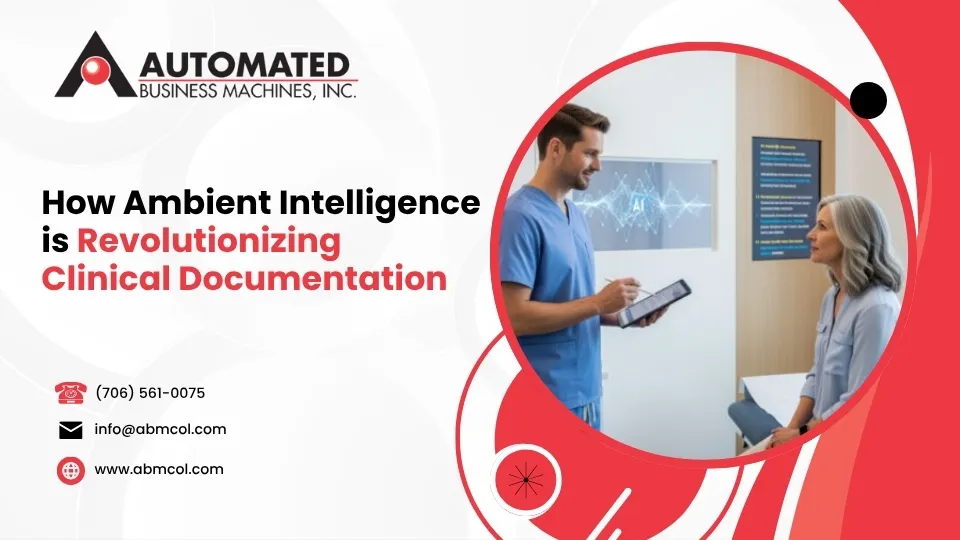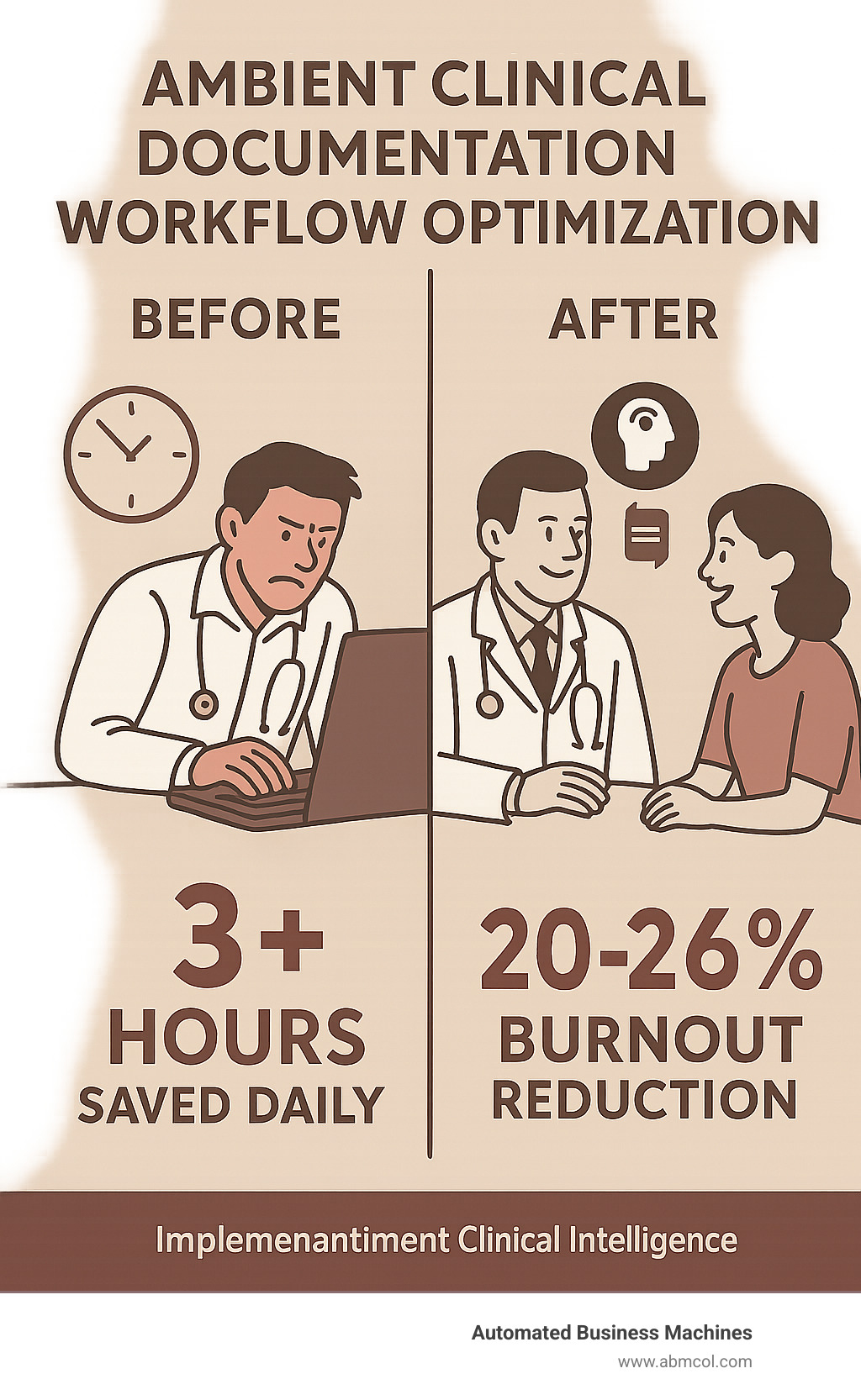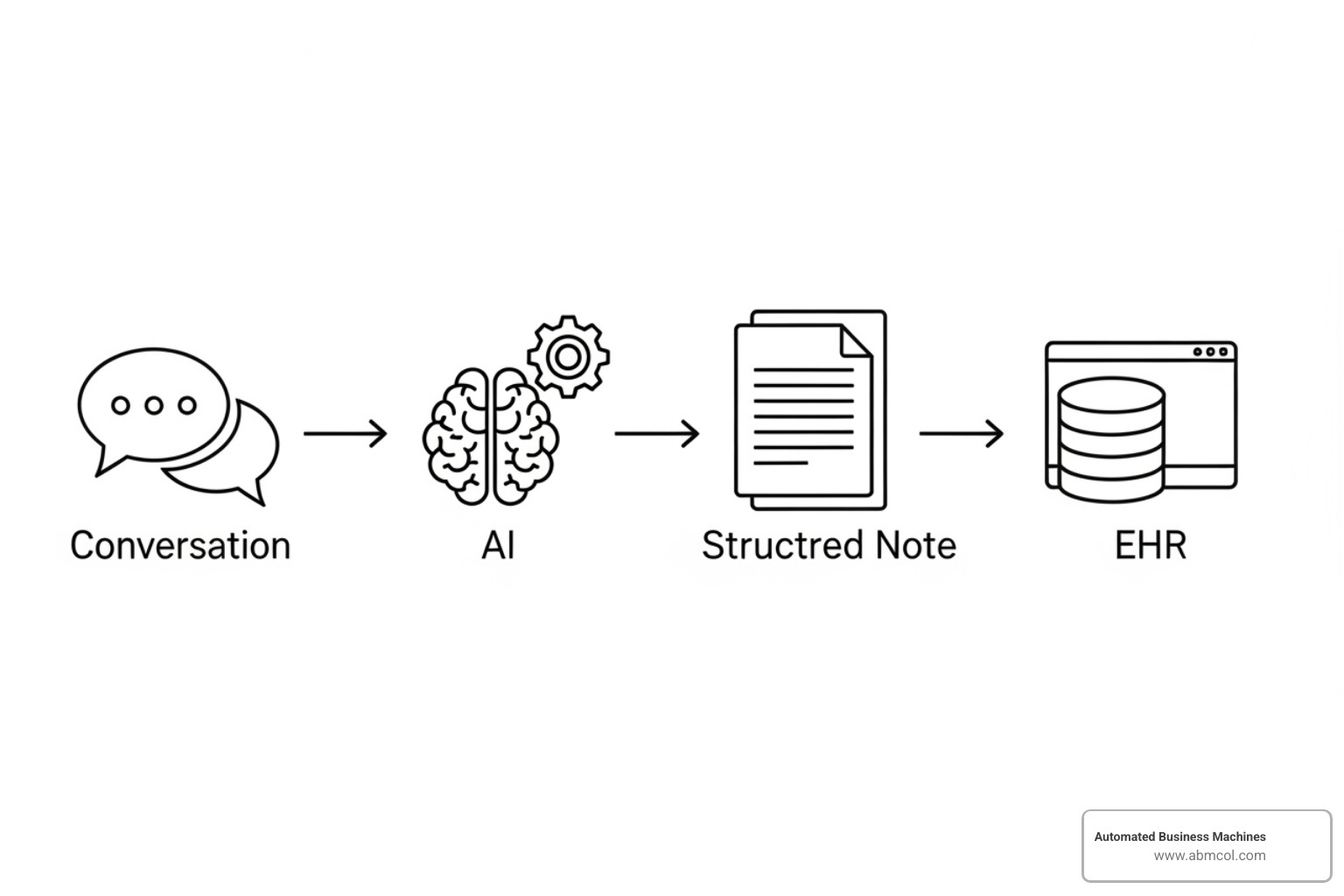
Ambient clinical documentation workflow optimization is changing how doctors handle paperwork, saving them hours each day and letting them focus on what matters most: their patients.
Key Benefits of Optimized Ambient Documentation:
- Time Savings: Up to 3+ hours saved daily on documentation
- Burnout Reduction: 20-26% decrease in clinician burnout symptoms
- Better Patient Care: 71-81% of patients report improved physician interaction
- Increased Efficiency: 30% more patient visits possible with time savings
- Higher Accuracy: AI-generated notes score 48 out of 50 on quality assessments
The numbers are stark. Doctors spend 26.6% of their day on documentation and work an extra 1.77 hours daily outside office hours. This “pajama time” is a major contributor to the 49% of physicians experiencing burnout.
One family physician captured the impact perfectly: “I left the clinic five minutes after my last patient with all of my notes done! This is a game changer.”
Traditional methods force doctors to choose between their computer screen and their patient. Ambient AI eliminates this conflict. It listens to natural conversations and automatically creates structured medical notes, allowing doctors to maintain eye contact and build stronger patient relationships.
Using advanced speech recognition and natural language processing, the technology captures conversations in real-time and transforms them into formatted SOAP notes that integrate with existing EHR systems.
The Crisis in Clinical Documentation: Why Change is Needed
The scene is familiar: a doctor finishes with patients for the day, only to face another two hours of typing. This reality is at the heart of a growing crisis in healthcare.
The numbers are staggering. Physicians spend 26.6% of their workday on documentation and take home an additional 1.77 hours of work daily, known as “pajama time.”
Electronic Health Records were intended to help, but 44% of clinicians cite EHR usability issues as a major source of stress. They wrestle with clunky interfaces, inconsistent terminology, and endless clicking instead of streamlined workflows.
This administrative overload has a severe impact. Nearly 49% of doctors report burnout, with 62% blaming excessive documentation. The financial toll is also alarming, costing the healthcare system $4.6 billion annually.
Beyond the numbers, 75% of healthcare professionals say documentation demands negatively impact patient care. When doctors are focused on screens, they can’t fully engage with the person in front of them.
Ambient clinical documentation workflow optimization offers a solution. It automates paperwork, allowing physicians to focus on healing people. This isn’t just about saving time; it’s about restoring the human connection at the core of medicine. Our Documentation Workflow Optimization Guide explores strategies to transform these burdensome processes into efficient, physician-friendly workflows.
What is Ambient Clinical Intelligence (ACI) and How Does It Work?
Imagine having a natural conversation with a patient while an invisible assistant creates your clinical notes automatically. When the visit ends, your documentation is formatted and ready for review. This is ambient clinical documentation workflow optimization, powered by Ambient Clinical Intelligence (ACI).
ACI combines Artificial Intelligence (AI), Machine Learning (ML), Natural Language Processing (NLP), and Automatic Speech Recognition (ASR) to understand and document medical conversations.
The process is simple. ACI listens to patient encounters, capturing context, not just words. It understands the difference between symptoms and treatment plans, recognizes medical terminology, and structures the information correctly. ACI doesn’t just transcribe—it understands, processing tone and emphasis to create accurate summaries, generate billing codes, and capture order information automatically.
Core Components and Functionalities
Key ACI components work together to streamline documentation. Real-time transcription and speaker diarization capture who is speaking. The system then creates structured data output in formats like SOAP notes, automatically organizing information into the correct sections.
Customizable templates adapt to your specialty and style, while contextual summarization highlights key information from complex visits. The technology also provides autonomous coding suggestions for billing, AI patient intake summaries, and multi-lingual speech recognition to support diverse patient populations. These features are central to modern Digital Document Workflows.
Seamless Integration with Healthcare Systems
Modern ACI solutions are designed for EHR compatibility with major systems like Epic, Cerner, and Athena, ensuring deep integration without disrupting workflows. Bi-directional data flow allows the AI to pull patient history from the EHR for context and push completed notes back into the record.
Robust API availability allows for custom integrations, while the system drives data quality improvement by standardizing capture and reducing manual entry. With rapid integration timelines—some as fast as two to six weeks—practices can quickly realize the benefits. This smooth process is supported by comprehensive Business IT Support Services that ensure technology works for you.
The Transformative Benefits of ACI for Clinicians and Organizations
Implementing ambient clinical documentation workflow optimization delivers transformative results for doctors, organizations, and patients. It addresses the documentation burden, improves efficiency, and improves the quality of care.
The benefits are clear: time savings of 3+ hours daily, improved accuracy with AI notes scoring 48 out of 50, increased patient throughput by up to 30%, and improved revenue capture through better coding. These outcomes create a healthier healthcare system. For organizations looking to maximize these benefits, our Managed Document Services Save Cost approach can provide additional operational efficiencies.
For Clinicians: Reclaiming Time and Reducing Burnout
With ACI, clinicians no longer have to choose between patient care and paperwork.
- Time Savings: Physicians cut documentation time in half, with some seeing 80% reductions. Outpatient visits become 26.3% shorter without sacrificing patient interaction time.
- Reduced “Pajama Time”: Doctors finish their notes during work hours, reclaiming their work-life balance.
- Lower Burnout: Organizations report a 20-26% reduction in burnout symptoms. 67% of clinicians said ACI reduced their burnout risk by easing documentation stress.
- Higher Job Satisfaction: At Kaiser Permanente, 82% of physicians reported greater job satisfaction with AI assistance, saying it “brings back the joy of medicine.”
- Deeper Patient Connections: With less time spent typing, doctors can offer their undivided attention. 84% of physicians felt AI improved their ability to connect with patients, and patients noticed. 71% reported more time talking with their doctor, and 81% said their doctor spent less time on the computer.
For Healthcare Organizations: Driving Efficiency and Quality
The benefits extend throughout the entire organization.
- Documentation Quality: AI-generated notes achieve an average quality score of 48 out of 50, outperforming standard EHR practices.
- Expanded Patient Capacity: Clinics can see up to 30% more patients, with some users generating an additional $54,000 in annual revenue. Northwestern Medicine saw a 112% ROI.
- Improved Data and Compliance: Standardized data capture reduces errors and inconsistencies. Accurate, automated coding for ICD-10, CPT, and E/M logic reduces audit risk and accelerates reimbursement.
- Stronger Care Coordination: Comprehensive health histories gathered by ACI facilitate personalized treatment plans and better care coordination.
The market for ambient intelligence is projected to grow to $112.8 billion by 2030, reflecting industry confidence. These benefits show why ACI aligns with our commitment to providing Custom Technology Solutions for Business Success.
A Practical Guide to Ambient Clinical Documentation Workflow Optimization
Implementing ambient clinical documentation workflow optimization requires careful planning. It’s not just about installing software; it’s about changing how people work.
A successful rollout focuses on these key areas:
- Implementation Strategy: Start with pilots before a larger deployment to allow for feedback. Identify clinical champions to advocate for the technology.
- Change Management: Provide comprehensive training, including webinars and at-the-elbow support. Foster a culture of innovation to encourage adoption.
- Security Protocols: Ensure the ACI solution is fully HIPAA-compliant with strong encryption, audit logs, and strict access rules for patient data.
- Patient Consent: Be transparent with patients about how AI is used. Obtain informed consent and provide clear materials explaining the process.
- Measuring ROI: Track key metrics like documentation time, patient visits, burnout rates, and satisfaction to demonstrate the return on investment.
Following these steps ensures our Digital Workflow Solutions lead to successful outcomes.
Ethical and Regulatory Considerations
ACI comes with important ethical and regulatory duties:
- HIPAA Compliance and Data Privacy: ACI tools must strictly adhere to HIPAA, using robust anonymization, secure storage, and access controls.
- AI Bias Mitigation: Systems must be built and monitored to serve all patient groups fairly, avoiding bias in documentation or recommendations.
- Physician Oversight Responsibility: ACI is an assistant. Clinicians must review, edit, and sign off on all AI-generated notes, retaining full responsibility for accuracy.
- Patient Consent Protocols: Clear protocols for obtaining patient consent are crucial for building trust and comfort with AI in the exam room.
Our approach integrates these considerations, ensuring our Secure Printing Software: Document Management solutions uphold the highest ethical standards.
The Future of Ambient Clinical Documentation
The journey of ambient clinical documentation workflow optimization is just beginning. Future advancements will further transform healthcare:
- Predictive Analytics: ACI will help identify early signs of disease and predict patient outcomes.
- Integration with IoT/Wearables: Data from sensors and wearables will integrate seamlessly into patient records.
- Generative AI Advancements: Future AI will offer more complex summarization and contextual understanding.
- Autonomous Coding: Coding capabilities will become more precise, accelerating revenue cycles.
- Clinical Decision Support Systems (CDSS): ACI will feed real-time, context-aware information into CDSS tools.
- Smart Healthcare Spaces: Ambient intelligence will be integrated into the physical environment.
These advancements highlight the evolution of our Office Technology Solutions Guide, keeping us at the forefront of innovation.
Frequently Asked Questions about Ambient Clinical Intelligence
Here are answers to common questions about ambient clinical documentation workflow optimization.
How accurate is ambient clinical documentation?
Ambient clinical documentation is highly accurate. Most systems achieve 95-98% accuracy, matching or exceeding human scribes. AI-generated notes consistently earn high-quality scores, averaging 48 out of 50 in large studies.
Accuracy for general medical terms is around 98%, while specialty-specific terms are about 95%. Specialties like gynecology and pediatrics see up to 34% better accuracy than traditional methods. The technology also captures nuances like tone and pauses, creating a comprehensive record.
Does ACI replace the need for clinicians to review notes?
Absolutely not. Physician responsibility remains paramount. ACI serves as an assistant, not a replacement.
The technology creates an efficient first draft, but the clinician is the expert. You must review, edit, and sign off on every document to ensure it accurately reflects your medical judgment. This approach combines the time-saving benefits of automation with complete clinical control over the final record.
How do patients feel about having AI listen to their appointments?
With transparency and informed consent, the patient response is overwhelmingly positive.
Patients feel more connected to their physicians. Studies show 71% of patients spent more time talking with their doctor, while 81% noticed their physician spent less time looking at a computer. This allows for better eye contact and deeper conversations.
When doctors can give their undivided attention, patients feel more heard. Explaining that the AI helps the physician focus entirely on them makes consent straightforward. The positive feedback shows that ACI, when implemented thoughtfully, improves the human connection in medicine.
Conclusion: Embracing a More Efficient Future in Healthcare
Ambient clinical documentation workflow optimization offers a powerful solution to the healthcare documentation crisis. This technology saves doctors over 3 hours daily, reduces burnout by up to 26%, and allows them to be more present with patients.
By blending AI, machine learning, and NLP, ACI acts as a skilled assistant, turning conversations into polished clinical notes. This allows doctors to focus on patients instead of screens. The benefits are clear: clinicians reclaim their personal time, organizations see up to 30% more patient capacity, and documentation quality scores reach 48 out of 50.
As one physician said, “I left the clinic five minutes after my last patient with all of my notes done! This is a game changer.”
The future is promising, with advancements in predictive analytics and integration with wearable devices. At Automated Business Machines, we understand this type of digital change. We help businesses across Georgia and Alabama streamline operations with advanced technology. Our locally owned company specializes in foundational digital workflows that boost productivity.
From secure printing to a complete Document Management System, we believe in technology that makes work easier. Ambient clinical intelligence follows this principle, eliminating busy work so professionals can focus on what matters. Embracing this technology means investing in provider well-being and patient care, bringing the joy back to medicine.




